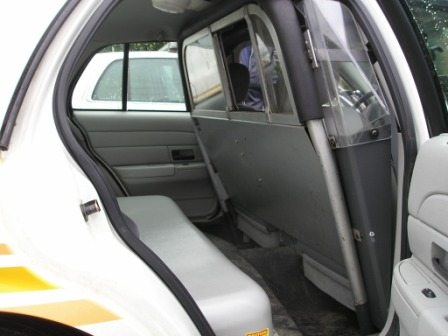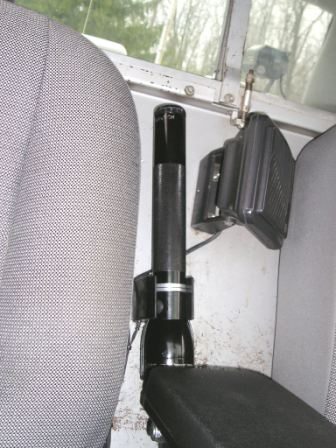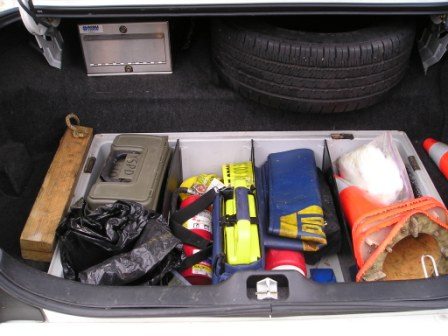Police Vehicles: Things You Don’t See…
You’ve all seen a police car, right? And they’re all the same, right? Flashing lights, reflective department logos, ugly tires and wheels, sirens, radar units, and spotlights. But what about the things you don’t see…
A protective screen separates the officer from the prisoner in the back seat. This screen is made from lightweight aluminum and Plexiglas. The glass is equipped with a sliding window to allow the officer to converse with the arrestee. The glass also prevents a prisoner from propelling body fluids to the front. And speaking of body fluids, this rear seat is made of hard plastic for easy cleaning. No carpet on the floor, either.
Window and door locks in the rear compartments of police cars are always disabled.
Mobile Vision monitor. When the officers engages the blue lights, the Mobile Vision camera is automatically activated. This particular monitor is mounted on the car ceiling near the sun visor.
Rechargeable flashlight mounted between the front seats, on the surface of the protective screen. The black object to the right of the flashlight is a speaker for the police radio.
Trunk of a patrol vehicle. L-R Fingerprint and evidence collection kit, garbage bags, fire extinguisher, barrier tape, defibrillator, first aid kit, tarp, traffic cones (body bag on the bottom of the pile). The aluminum box pictured next to the spare tire contains the recording equipment for the Mobile Vision camera.
Portable defibrillator.










SZ – I’ll answer your question off-site in an email.
Hello Lee,
If you still read this, I do try to look in your book first, and will look on line.
Please may I ask what it was like to do CPR those two times ?
I could not find anything that reads of this. Just curious of your experience.
I hope the county of which I spoke has moved to include defibrillators. I never understood the thinking behind an elected official who thought saving lives was not part of an officer’s job. But then she wasn’t reelected after her first term due to problems with situational ethics.
Hey Peg, I’m with DH – have the same problem and it makes me cranky to not be considered part of the loop!
DH had first responder training, saved several lives, but remembers the two he couldn’t save the most.
All his department’s cars had defibrillators.
In his opinion there was one problem with having first responder training and that problem is: he uderstood waaaay too much the nurses were saying when he had a severe medical problem this year.
Elena – Not all police departments equip their patrol cars with defibrillators, but they’re much more common today than even a few years ago. The one in the photo above is in a small village in Ohio. Population of approximately 4,000 people.
There is grant money available that can be used for purchasing equipment like the defibrillator.
I have to disagree that it’s not part of a police officer’s job to save someone’s life, if possible. The defibrillators you find in police cars are very easy to use. In fact, they “talk” and tell the operator what to do and when to do it. There’s also a short course that officers must attend before using the equipment.
Most police officers are required to be certified as a first responder which is a step or so below an EMT certification. They’re also required to maintain CPR certification.
I performed CPR twice during my career.
I was very surprised to see the defibrillator. One of the departments I worked with was not allowed to have them even when a citizen offered to outfit every car. The rationale was that was not the officer’s job.
Another city just flat out couldn’t afford them.
Are they common? How much medical training do officers get?
SZ – The recorder is automatically activated when the officer switches o the blue lights. It continues recording throughout the stop. Yes, the recordings are allowed in court as evidence.
I like the mobile vision monitor. Is it recording after the stop ? Is the recordings allowed in court ?